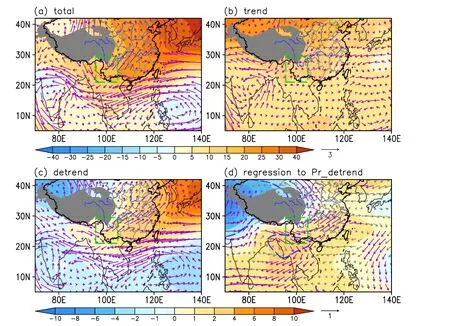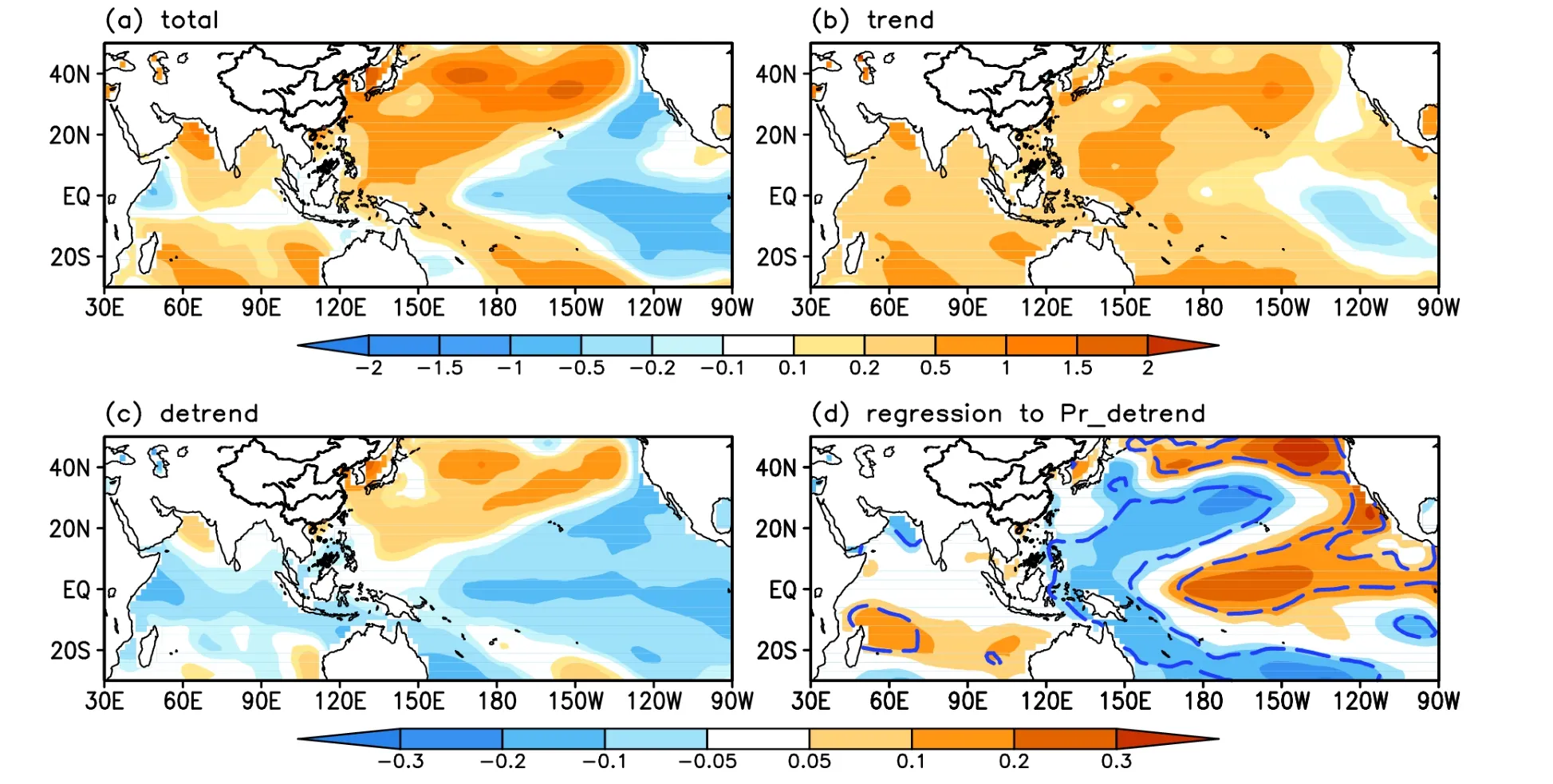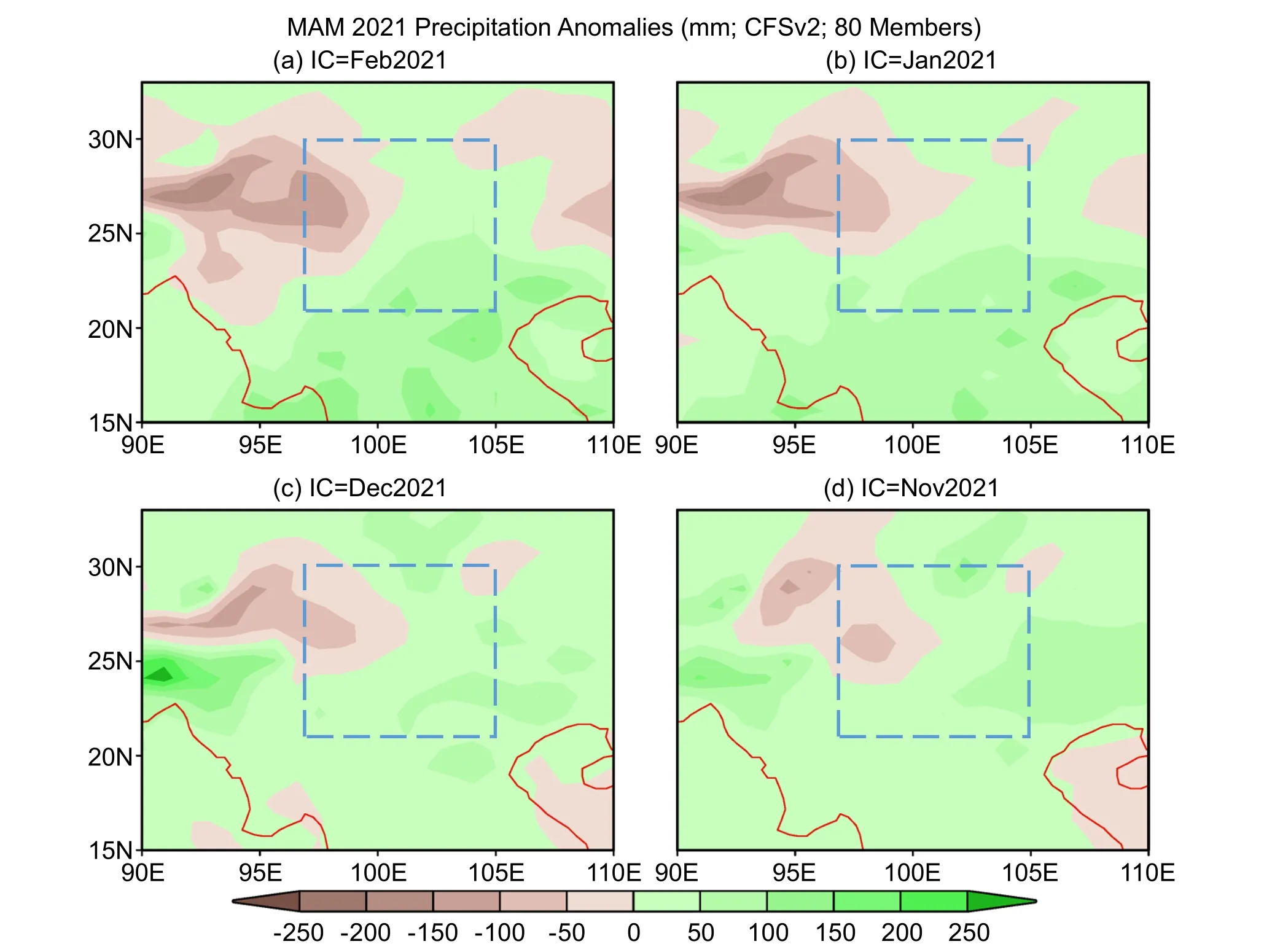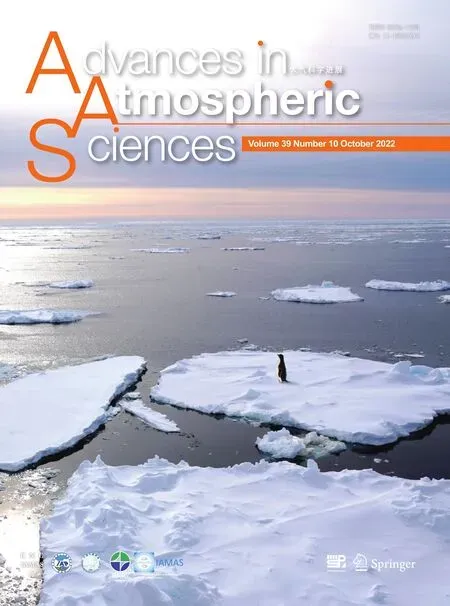Causes and Predictability of the 2021 Spring Southwestern China Severe Drought
Yunyun LIU, Zeng-Zhen HU, Renguang WU, and Xing YUAN
1CMA Climate Studies Key Laboratory, National Climate Center, China Meteorological Administration,Beijing 100081, China
2Key Laboratory of Meteorological Disaster, Ministry of Education & Collaborative Innovation Center on Forecast and Evaluation of Meteorological Disasters, Nanjing University of Information Science & Technology, Nanjing 210044, China
3Climate Prediction Center, NCEP/NOAA, College Park, Maryland 20740, USA
4School of Earth Sciences, Zhejiang University, Hangzhou 310058, China
5School of Hydrology and Water Resources, Nanjing University of Information Science and Technology,Nanjing 210044, China
ABSTRACT
Key words: extreme spring drought, Southwestern China, precipitation, evaporation, warming trend, internal variability,predictability
1. Introduction
Southwestern China (SWC), being located on the southeastern side of the Tibetan Plateau, is influenced by both southwesterly and southeasterly winds during the summer monsoon period, resulting in pronounced dry and rainy seasons in the annual cycle. Spring drought before the onset of the summer rainy season is common throughout SWC(Jiang et al., 2016; Cao et al., 2017), which poses a great threat to local ecology, agriculture, and economy. Spring precipitation in SWC has decreased during recent decades in the presence of persistent warming (Wang et al., 2015; Lu et al., 2021), accompanied by more frequent and severe droughts, especially since 2006 (Qiu, 2010; Wang et al.,2015; Ren et al., 2017; Yuan et al., 2019; Lu et al., 2021).In the spring of 2021, SWC again experienced an extreme drought event, with an intensive precipitation deficit and the highest seasonal mean temperature record since 1961. According to the statistics reported by the Chinese government,this severe drought together with high temperatures damaged more than 640,000 hectares of crops with rice, corn, and potatoes (Liu and Gao, 2021).
Previous research has explored the possible causes of drought in SWC (Wang et al., 2015; Ren et al., 2017). Studies have identified the roles of persistent external forcing, such as sea surface temperature anomaly (SSTA) in the tropical Pacific and Indian Oceans (Yang et al., 2011; Hu et al.,2012, 2020a; Feng et al., 2014), tropical Madden-Julian oscillation (MJO) (Lü et al., 2012), and anomalous snow cover in the Northern Hemisphere (He et al., 2013), on the SWC drought through changing the atmospheric variability. Atmospheric circulation anomalies, such as the westward shift and intensification of the western Pacific subtropical high(WPSH)(Yang et al., 2012), the weakened India-Burma trough (IBT) (Ding and Gao, 2020), and the northward shift of the midlatitude westerlies (Sun and Yang, 2012), have been shown to contribute directly to the precipitation deficit in SWC. Yan et al. (2007) noted the important roles of the sustained easterly anomaly at 850-hPa over the North Indian Ocean and the continuous enhancement and westward extension of WPSH. Liu et al. (2007) argued that delayed onset of the South China Sea summer monsoon, suppressed tropical convection, and intensified and southwestward extension of the WPSH were important factors for the severe drought in SWC in spring 2005. Historically, the precipitation deficit from spring to summer in SWC is often concurrent with El Niño (Yang et al., 2011). During an El Niño event, an anomalous easterly wind develops over the Arabian Sea and the Bay of Bengal (BOB) in the lower troposphere accompanying by an anomalous anticyclone over the BOB and a stronger WPSH.
However, it is still unclear to what extent the SSTA affects SWC drought, how robust the impacts of the El Niño-Southern Oscillation (ENSO) and WPSH are on the spring droughts in SWC, and what is the predictability of the drought (Lu et al., 2021; Wang et al., 2021). Moreover, the effect of the warming trend on such droughts with high air temperature and associated high evaporation over SWC remains to be investigated. Our analysis reveals distinct features in the occurrence of the SWC drought in the spring of 2021 compared to the historical perspective. This study assesses the contribution of the warming trend to the SWC spring drought in 2021, analyzes the roles of anomalous atmospheric circula-tion and tropical SST, and explores the predictability of drought based on a state-of-the-art climate prediction model. The remainder of the paper is organized as follows. Section 2 describes the data and methods used in this study. The characteristics, possible factors, contributions of the long-term trend and internal variability, and predictability of the extreme drought are addressed in section 3. Section 4 is a summary and discussion.
2. Data and methods
Observations of monthly mean near-surface air temperature at two meters above the surface (T2m), precipitation,and surface potential evaporation (pan evaporation) at 125 national meteorological stations of China were used in this work. The station data were rigorously quality-controlled and homogenized at the China National Meteorological Information Center (Yang and Li, 2014). In addition, the National Oceanic and Atmospheric Administration(NOAA)'s grid precipitation reconstruction dataset with a 0.5° × 0.5° horizontal resolution (Chen et al., 2002), and the fifth-generation reanalysis dataset from the European Centre for Medium-Range Weather Forecasts (ERA5; Hersbach et al., 2020) with a 0.25° × 0.25° horizontal resolution were used in this work. Atmospheric variables analyzed in the present study include 500-hPa geopotential height (Z500)and vertical velocity (ω500), 850-hPa specific humidity(q850), and 700-hPa zonal and meridional winds (UV700)from ERA5. Monthly mean SST on a 2° × 2° resolution,which was extracted from NOAA Extended Reconstructed SST, version 5 (ERSSTv5; Huang et al., 2017), was used to examine the contribution of external/boundary forcing to this drought event.
The Standard Precipitation Evaporation Index (SPEI) is defined as a monthly climatic water balance of precipitation minus evaporation, reflecting the meteorological drought severity (Vicente-Serrano et al., 2010a). SPEI was suggested to be more appropriate than other drought indices (Vicente-Serrano et al., 2010b), such as the Standard Precipitation Index (SPI, McKee et al., 1993) and Palmer Drought Severity Index (PDSI, Palmer, 1965) due to the fact that SPEI is defined as the water balance (i.e., monthly precipitation minus evaporation) instead of precipitation itself. In this work, SPEI is used to represent the drought severity in MAM 2021.

where P is the precipitation and E is the evaporation. The evaporation (E) is further divided into a linear trend component since 1991 and a detrended component after removing the linear trend. The former represents the warming trend and the latter represents the interannual variability. Then,the relative contributions of the linear trend and interannual variability of the evaporation are calculated based on the above equation.
The real-time predictions from the NCEP Climate Forecast System version 2 (CFSv2; Xue et al., 2013; Saha et al.,2014; Hu et al., 2017) were examined in this study to assess the predictability of this drought event. The real-time predictions include 80 members within the last 20 days of each month and four forecasts per day, out to 9 months.
The present study focused on the spring (March-April-May, MAM) season covering the period of 1961-2021.Anomalies of all variables were defined as the deviations from the climatological mean of MAM for the period 1982-2010, being consistent with the CFSv2 hindcast period. Pearson correlation and linear regression were used in this study. The statistical significance of the correlation was estimated using the two-tailed Student’s t-test.

Fig. 1. Distributions of (a) precipitation (mm), (b) T2m (°C), (c) evaporation (mm), and (d) drought (difference of precipitation minus evaporation) anomalies in MAM 2021. Contour indicates the anomalies, and shading represents normalized anomalies. The green dashed rectangle is the region of SWC (97°-105°E, 21°-30°N). The grey shading denotes the Tibetan Plateau with the elevation exceeding 3000 m.
3. Results
3.1. Extreme 2021 spring drought over SWC
The spring drought event in 2021 over SWC (mostly over Yunnan Province) was mainly confined to the region of 21°-30°N, 97°-105°E (Fig. 1). According to the spatial distribution of March-April-May (MAM) mean precipitation anomalies during 2021, precipitation was 30-180 mm less than the climatic mean in SWC, with a widespread deficit of rainfall over most of the Yunnan province, particularly in the western region (Fig. 1a). The area-averaged rainfall amount in MAM 2021 was unprecedentedly low with the value of 110 mm, about 80 mm less than the climate mean(190 mm), reaching -1.6 times the standard deviation of precipitation over the period (Fig. 2a). In addition, SWC suffered the warmest spring since 1961, with the temperature being 1°C higher than normal in most of SWC (Fig. 1b). The areaaveraged T2m anomaly in MAM 2021 was ranked highest since 1961 (Fig. 2b), reaching 2.8 times the standard deviation.

Fig. 2. Time series of MAM (a) precipitation, (b) temperature, (c) evaporation, and (d)drought anomalies averaged over SWC from 1961 to 2021. Bars indicate the anomalies (left yaxis), grey curves represent the accumulated anomalies (right y-axis), and dashed bold lines are the linear trend of 1991-2021. Accumulative anomaly is the accumulation of individual year anomaly values starting from 1961. The superscript * and ** in the trend equations represent significance levels of 0.05 and 0.01 respectively, based on the t-test.
Surface evaporation over SWC was 30-60 mm above the climatology (Fig. 1c) due to the high temperature (Fig.1b). The regional average evaporation anomaly in MAM 2021 was extremely large, exceeding 2.8 standard deviations(Fig. 2c). Such abnormal evaporation amplified the drought severity in the region. Under the combined effect of precipitation deficit and high evaporation, a severe drought, as measured by precipitation minus evaporation, formed in SWC in spring 2021, covering most of Yunnan and southern Sichuan provinces (Fig. 1d).

Table 1. The contribution of evaporation to the spring drought in 2021.
The accumulative anomalies of SWC temperature and evaporation reached the lowest value in 1990 (Figs. 2a, 2c).The temperature and evaporation showed significant linear increasing trends from 1991 to 2021 (p<0.01). Although the corresponding linear trend of precipitation is not significant,the drought characterized by the difference between precipitation and evaporation over SWC has increased in the recent 30 years, which is consistent with previous studies (Wang et al., 2015, 2021; Lu et al., 2021). Specifically, the precipitation and evaporation contributed about 70% and 30% to the 2021 spring drought, respectively. Among the total contribution, the linear trend component of the evaporation accounted for about 20% and its interannual variability was about 10% (Table 1).

Fig. 3. (a) Observed Z500 (gpm) & UV700 (m s-1), (b) linear trend components, and (c) detrended components in MAM 2021; (d) regressions of Z500 and UV700 onto negative detrended MAM precipitation in SWC. Blue dashed lines in (d) indicate the anomalies reaching the 0.05 significance level based on the t-test. The grey shading denotes the Tibetan Plateau with the elevation exceeding 3000 m.
3.2. Atmospheric circulation anomalies associated with the extreme drought event
In the spring of 2021, easterly anomalies were located over the latitudes of 15°-20°N, and two anomalous anticyclones were present, one extending northeastward from the southeastern China to the mid-latitudes and the other located over the northern BOB-northeast India (Fig. 3a).The anticyclone over the northern BOB-northeast India weakened the India-Burma trough (IBT), impeding the water vapor transport from the BOB to the SWC region (Wang et al., 2015; Ren et al., 2017; Ding and Gao, 2020). In addition,the southward flow of cold air northeast of the Tibetan Plateau was weaker than normal, suppressing the coldwarm air convergence. As a result, anomalous descent and reduced low-level moisture were observed over the SWC(Fig. 4a), favoring a precipitation deficit. The anomalous anticyclone and descent led to an enhancement of downward shortwave radiation reaching the surface and an increase of surface temperature. Thus, SWC was characterized by high temperature and severe drought in MAM 2021 (Fig. 1).
The above anomalous atmospheric circulation pattern in MAM 2021 (Fig. 3a) is different from that during the record-breaking drought in MAM 2019. In MAM 2019, the low-latitude region was dominated by positive geopotential height anomalies, and WPSH was strengthened with its ridgeline shifting northward and extending westward. The intensification and westward shift of the WPSH weakened the southern branch of the IBT and led to extreme drought (Yang et al., 2012; Ding and Gao, 2020; Wang et al., 2021). In MAM 2021, however, there were negative geopotential height anomalies over the Philippine Sea (Fig. 3a).

Fig. 4. (a) Observed q850 (shading, g kg-1) and ω500 (contour, -0.01 Pa s-1) anomalies in MAM 2021; (b) regressions of q850 (shading, g kg-1) and ω500 (contour, -0.01 Pa s-1)anomalies onto negative detrended MAM precipitation in SWC. The green dashed rectangle is the region of SWC, and the grey shading denotes the Tibetan Plateau with the elevation exceeding 3000 m.
The positive geopotential height anomalies over the low-latitude region in MAM 2021 may be partially associated with the interdecadal variation and long-term trend (Fig. 3b).After removing the linear trend, the low-latitude area, especially the Philippine Sea, is still dominated by negative height anomalies (Fig. 3c). Historically, atmospheric circulation anomalies obtained by linear regression onto the negative detrended precipitation anomaly averaged over SWC shows the contribution of the interannual component (Fig. 3d). The two anomalous anticyclones over the northern BOB and southeastern coast of China led to upper-level divergence over SWC. Unlike that inferred from the regression pattern,anomalous anticyclones are located at higher latitudes, and the low latitude region is occupied by anomalous cyclones in MAM 2021 (Figs. 3a, d). This is accompanied by a difference in the anomalous vertical motion around the Philippines(Figs. 4a, b). The differences of anomalous circulation patterns in the low latitudes between MAM 2021 (Figs. 3c, 4a)and the regression pattern (Figs. 3d, 4b) imply a different role of the low-latitude atmospheric circulation in drought in MAM 2021 and historical events.

Fig. 5. (a) Observed SSTA (°C), (b) the linear trend component, and (c) the detrended component in MAM 2021; (d)regressions of detrended SSTA onto negative detrended MAM precipitation in SWC. Dashed lines indicate anomalies reaching the 0.05 significance level based on the t-test.
The SWC extreme drought in 2021 occurred in the context of the decaying phase of a La Niña event (Fig. 5a; Li et al., 2022), under the warming trend of SST in the central and western Pacific (Figs. 5b, c). Especially, the linear warming trend of tropical SST near 150°E is the most pronounced, which may be due to the frequent occurrence of the central Pacific El Niño events in recent decades (Yeh et al., 2009; Hu et al., 2012, 2020a; Yu and Kim, 2013). However, in the regression of the SSTA onto the negative detrended MAM precipitation in SWC, the pattern of “west cold and east warm” SSTA, similar to the El Niño-like pattern, favors drought in SWC (Fig. 5d) (e.g., Feng et al.,2014; Cao et al., 2017; Ding and Gao, 2020). Nevertheless,the SST anomaly gradient between the equatorial and southern Indian Ocean shares some similarities though the distribution of SST anomalies that are dissimilar to the equatorial and northern Indian Ocean between the regressions and the observations (Figs. 5a, c, d). The possible role of the SST anomaly gradient in the drought in SWC in the spring of 2021 deserves further investigation.
From a historical perspective, the anticyclonic wind anomalies are located at lower latitudes (BOB and southeast coast of China), likely resulting from a combined effect of positive SST anomalies in the equatorial central-eastern Pacific and negative SST anomalies in the tropical western North Pacific (Figs. 3d, 5d) (Wang et al., 2000; Wu and Wang, 2000; Yang, 2011). In MAM 2021, however, the positive SST anomalies extending from the tropical western North Pacific to the mid-latitude North Pacific may be a factor for the cyclonic wind anomalies over the BOB and the Philippine Sea (Figs. 3c, 5c), which differs from the historical statistics. Associated with the above cyclonic wind anomalies,the anticyclonic wind anomalies are shifted northward,being located over the top of the BOB and southern China-Japan. The differences in the low-latitude wind anomalies may be partially related to the contribution of the warming trend in the 2021 event (Fig. 5b). Thus, the differences of the low-latitude circulation anomalies in MAM 2021 from those in historical records associated with spring SWC drought are consistent with those in the tropical SSTA and ENSO condition (Figs. 5a and 5d).
3.3. Predictability of the extreme drought event
The differences in the atmospheric circulation and SST anomalies in MAM 2021 (Figs. 3a, 3c, 5a, 5c) from the historical perspective (Figs. 3d, 5d) imply that the SWC extreme spring drought in 2021 may be more likely caused by the atmospheric internal variability within the longer-term warming background. The SST forcing in the tropical central and eastern Pacific seems not to play a key role. That is confirmed by the real-time prediction of CFSv2.
The ensemble means of the CFSv2 predictions appear unable to capture the precipitation deficit in SWC at the lead times beyond one month (Fig. 6). The precipitation deficit was predicted only in a small part of western SWC,with an obvious underestimation of the drought severity. Statistically, it has been suggested that only a small fraction of the interannual variability of precipitation in China is driven by the oceanic forcing, mostly associated with ENSO (Lau and Nath, 2003; Wu et al., 2003; Chang et al., 2004; Jang et al., 2016; Liang et al., 2019; Liu et al., 2019, 2021).

Fig. 6. CFSv2 real-time forecasts of precipitation anomalies (mm) in spring 2021 with initial conditions in (a)February 2021, (b) January 2021, (c) December 2020, and (d) November 2020. The forecasts are 80-member ensemble mean. The blue dashed rectangle represents SWC, same as that in Fig. 1.
To further reveal the role of the atmospheric internal dynamical processes in the 2021 spring drought in SWC,Figure 7 shows the ensemble means of the five driest and wettest ensemble members in the region. The selection is based on the precipitation anomalies averaged in the domain among the 80-members of the real-time forecasts of CFSv2 with different initial conditions. With the same boundary (SST) forcing, the differences of the subgroup averages(Fig. 7) are largely attributed to the contribution from the atmospheric internal variability. The ensemble means of the two subsets exhibit nearly opposite precipitation anomalies in SWC. This indicates that under the same boundary (SST)forcing, some ensemble members can capture the drought to some extent while other ensemble members cannot. This further suggests that this drought event may be largely driven by the atmospheric internal dynamical processes with low predictability, which is distinct from the historical perspective.In fact, this is an inherent feature of most extratropical land precipitation anomalies, and the predictability is consistently low for the seasonal-interannual (not the long-term tendency) aspect of the drought (Liang et al., 2019; Hu et al.,2020b; see CFSv2 prediction skill at (https://www.cpc.ncep.noaa.gov/products/NMME/archive/2021020800/current/images/skill_NMME_ensemble_prate_season1.png).
4. Summary and discussion
In the spring of 2021, SWC experienced extreme meteorological drought, accompanied by high temperatures. The contribution of anomalously high temperature to the drought was mainly through increasing evaporation, which accounts for about 30% of the drought severity. Among the 30%, the contribution of its linear trend portion is nearly 20%and that of the interannual variability portion is about 10%.This implies a crucial role of the long-term warming trend in regional climate variability.
Such an extreme event occurred in the decaying phase of a La Niña within the context of a long-term warming.Moreover, negative geopotential height anomalies were present east of the Philippine Sea. Those differ significantly from the historical perspective. Historically, spring drought in SWC is often linked to El Niño and strong WPSH. Our analyses indicate that the extreme drought in spring 2021 may be more likely driven by the atmospheric internal variability and amplified by the warming trend. The boundary forcing, such as SSTA in the tropical central and eastern Pacific, played a minor role.
It is a challenge for a climate model to capture such an extreme drought event over SWC with the lead times beyond one month. This may be because this event was mainly caused by the atmospheric internal variability,which is poorly predicted. The boundary forcing (such as SST) played a minor role in the occurrence of drought,which is a common feature of extratropical land climate variability (e.g., Liang et al., 2019; Hu et al., 2020b).
The present analysis indicates that the climatic conditions of the SWC spring drought in 2021 are distinct from the historical perspective. There were negative geopotential height and anomalous cyclone at the low latitude region of the western North Pacific, which are different from the regression pattern. However, the anomalous anticyclone still existed from the southeastern coast of China to southern Japan, but located much farther northward than that in El Niño years.In addition, the IBT was weaker than normal, which is similar to the circulation anomaly in 2019 that was related to an El Niño event. This may imply that there may be a nonlinear relationship between the SWC drought and the tropical Pacific SST anomalies: both El Niño and La Niña events can lead to the drought in SWC through different mechanisms. That deserves further investigation through diagnosis and model experiments.
Acknowledgements. The authors appreciated the constructive comments and insightful suggestions from reviewers, which have helped us to improve the paper significantly. This work was jointly supported by the National Key R&D Program of China (Grant No.2017YFA0605004), Guangdong Major Project of Basic and Applied Basic Research (Grant No. 2020B0301030004), National Natural Science Foundations of China (Grant No. 42175056), the China Meteorological Administration Innovation and Development Project (CXFZ2022J031), and the Joint Open Project of KLME &CIC-FEMD, NUIST (Grant No. KLME202102).
 Advances in Atmospheric Sciences2022年10期
Advances in Atmospheric Sciences2022年10期
- Advances in Atmospheric Sciences的其它文章
- An Unprecedented Record Low Antarctic Sea-ice Extent during Austral Summer 2022
- 2021: A Year of Unprecedented Climate Extremes in Eastern Asia,North America, and Europe
- Transport Patterns and Potential Sources of Atmospheric Pollution during the XXIV Olympic Winter Games Period
- Observational Subseasonal Variability of the PM2.5 Concentration in the Beijing-Tianjin-Hebei Area during the January 2021 Sudden Stratospheric Warming
- An Extreme Drought over South China in 2020/21 Concurrent with an Unprecedented Warm Northwest Pacific and La Niña
- How Well Do CMIP6 and CMIP5 Models Simulate the Climatological Seasonal Variations in Ocean Salinity?
